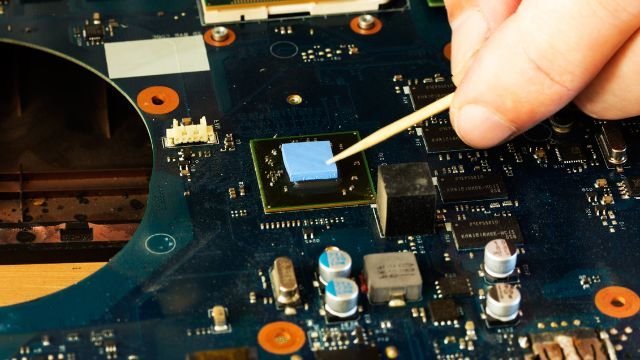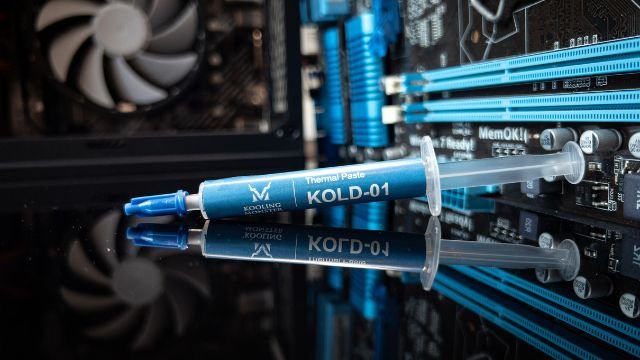Can Laptop Thermal Pad Be Replaced With Paste?
Replacing your old thermal interface with a new one is bound to be an exciting job. After years of using the same interface, one expects noticeable thermal performance gains through this replacement.
However, this job is not exactly the easiest out there.
There are many questions that come with it. For instance, can you replace a thermal pad with thermal paste in your laptop? What’s the difference between the two? Which is better?
What’s the difference between thermal pad and thermal paste?
As the name suggests, a thermal pad is a mat-like material that comes in various rectangular sizes. Ideally, you have to find the exact size that could fit your CPU/GPU.
Thermal pads are easier to handle compared to thermal paste. As they come pre-cut, you just have to put them, like a sticker, on top of your CPU/GPU — and you’re good to go.
However, that convenience comes with a trade-off in terms of thermal performance. As it’s a solid mat, it cannot fill in all the air gaps between the CPU/GPU and heatsink. So thermal pads can’t transfer the heat between components as well as thermal paste can.
Speaking of thermal paste, it’s a paste-like material that serves well to fill in all the tiny air gaps between the CPU and heatsink and has much better thermal conductivity.
But it’s not as easy to apply compared to thermal pads. You have to learn to use the correct amount for your exact CPU/GPU size. But — once you’ve got the hang of it and you know what different application methods are, it’s pretty easy.
Learn more about CPU Thermal Paste vs Thermal Pad: Which Is the Best?
Can a laptop thermal pad be replaced with thermal paste?
Once you notice that your laptop overheats, you need to check whether thermal pads are applied on the CPU/GPU. If that's the case, you can replace the pads with high-performance thermal paste to ensure your computer operates at peak performance and under a safe temperature range.
Thermal pad vs. Thermal paste, which is better?
For CPU and GPU, thermal paste is easily the best option. That’s because these components produce a lot of heat under heavy load, and you need as-good-as-possible thermal transferability to eliminate that. Thermal paste provides that.
For RAM and other small chips, a thermal pad is a better option. That’s because smaller chips don’t give you a lot of space to work with. Applying the perfect amount of paste on the right spots is very difficult. Plus, these chips don’t produce a lot of heat anyway. Considering that it’s easier to handle a thermal pad, and it has just enough thermal transferability for smaller chips, it’s the preferred choice for RAM sticks and other small chips.
Learn more about When We Replace CPU or GPU Thermal Paste, What to Do With the Thermal Pads on RAM and Other Chips?
How to choose the right thermal pad or thermal paste for a laptop?
A good thermal paste has high heat transferability, easy to apply, and has a long life span.
When choosing your thermal paste, you need to look for all these properties.
Luckily, we have created a thermal paste for you that has all these properties. We call it Kooling Monster KOLD-01.
KOLD-01 has high thermal performance, which means it can effectively transfer even the highest levels of heat.
It has a rheological structure, which gives it its unique formation. When you’re actively spreading it with your spatula, or just the pressure of the heat sink, it moves very easily. But, when you’re done moving it, it holds its position and never flows around.
If you’re shopping for a thermal pad for your RAM or other chips, you need to find one that has the exact dimensions you need. Plus, you must also look for high heat transferability, which will ensure that your pad works for a longer span without causing thermal problems.
How often to change the thermal interface on a laptop?
It depends on the quality of your thermal interface, as well as the work you do on your computer.
If you do intensive tasks on your computer every day, like gaming or video rendering, you will need to replace the paste more often.
On the other hand, if you don’t do anything intensive on it and only use it for things like web browsing or writing school essays, your interface will last longer.
At the same time, the quality of the interface is also a major variable.
A good-quality thermal paste, like KOLD-01, will easily last you at least 2 years if you do intensive tasks on your laptop every day, and more than 5 years if you use it casually.
On the other hand, a bad thermal paste will last you only for around a year or two. If you do intensive tasks on your laptop every day, it will last even shorter.
Learn more about How often should you replace thermal paste?
The bottom line
If your laptop came with a thermal pad on the CPU/GPU, you’d better replace it with thermal paste.
As for RAM and other chips, thermal pads are acceptable. If you want to use thermal paste on them, you need to be careful enough.




